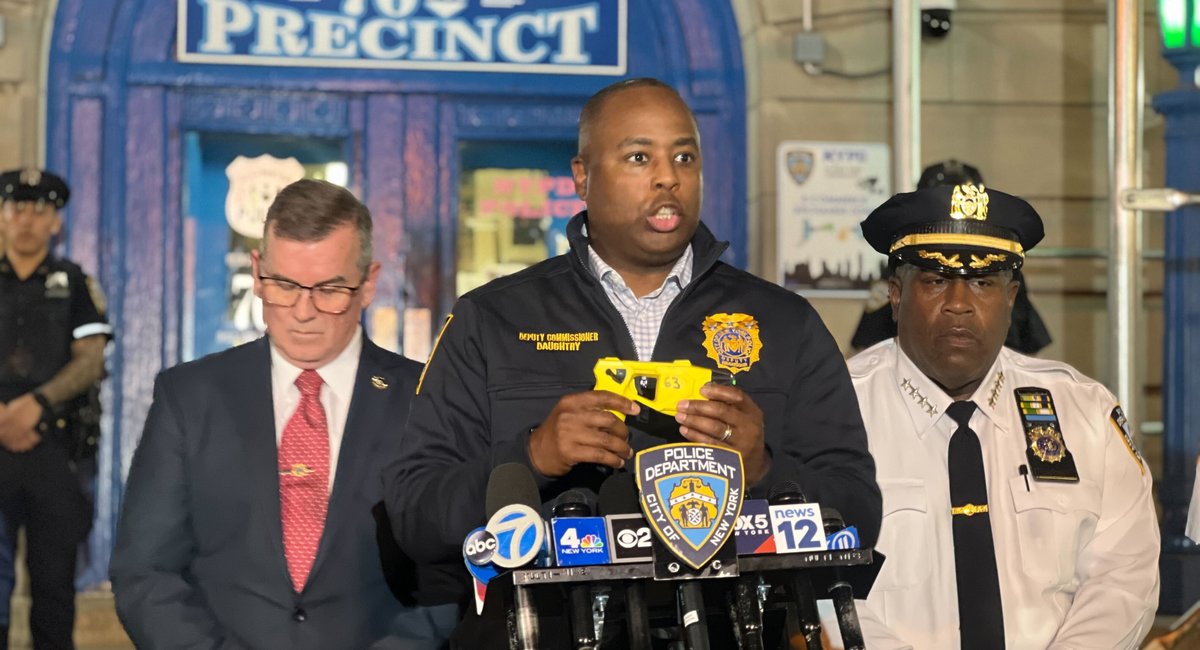Before police shot at Derell Mickles and two bystanders at the Sutter Ave. L train station in Brownsville on Sunday, officers first tried to use Tasers.
The NYPD said those attempts were “ineffective.”
It’s a problem that has plagued the NYPD and police departments across the country for years. Tasers have failed roughly 40% of the time since the NYPD began issuing more of the devices to its officers nearly a decade ago, according to the department’s own data, and police experts say a Taser’s failure can increase the likelihood that officers will then use deadly force.
“The Taser is the most complicated weapon that police have,” said Chuck Wexler, executive director of the nonprofit think tank Police Executive Research Forum.
Police officers generally need to be within 15 feet of a person for a Taser to be effective, according to major Taser manufacturers like Axon. Wexler said that close proximity can cause officers to feel they’re in greater danger when the weapon fails.
“Officers then think they have no alternative other than to use deadly force,” Wexler said. “It’s a two-sided sword.”
Sunday’s shooting was the second NYPD shooting within 48 hours in which officers first tried to use a Taser, according to officials. On Friday, police shot and killed a man inside a Brooklyn apartment.
Two days later, police attempted to stop Mickles for alleged fare evasion, following him through the subway station and onto the platform. They said he refused to comply with orders, threatened to kill the officers and also told them to shoot him. Officers attempted to Tase Mickles to no avail. He then pulled out a knife, police officials said, which is when officers shot him.
The NYPD has long used Tasers, but it began rolling them out to more of its officers starting in 2015. By 2017, more than 16,000 uniformed officers were trained to use a Taser — marking a 52% increase from the previous year. By 2022, nearly three-quarters of the NYPD’s force of more than 36,000 uniformed officers were trained in using Tasers.
But Tasers have been effective 60% of the time since about 2017, according to NYPD data. There was a slight uptick in 2020 and 2021, when Tasers worked roughly 66% of the time, but that figure dropped again in 2022, the most recent years for which data is available.
NYPD officers were most likely to discharge Tasers during a crime in progress or to subdue an “emotionally disturbed person,” according to 2022 department data. Officers also used Tasers during traffic violations, for crowd control and while issuing restraining orders.
Although most officers are trained to use the non-lethal weapon, not all of them carry one at all times. Tasers are instead distributed on a rotating basis across precincts, transit and housing units. As of 2022, there were nearly 9,000 Tasers allocated for the department. The NYPD received $2.2 million in federal funding earlier this year, some of which was intended to replace out-of-date Tasers.
There is no standard police protocol for when officers should discharge a Taser, according to NYPD Deputy Commissioner of Public Information Tarik Sheppard. Individual officers have discretion over how they respond to threats of force, he said.
“They have to make quick decisions and analyze a hundred things going through their mind,” he said.
David LaFauci, who witnessed the shooting on Sunday, said he saw Mickles pull one Taser prong off his body after it hit him in the buttocks.
When Tasers fail, it’s typically for three main reasons, according to policing expert Ed Obayashi, who advises the city’s police oversight agency on use of force cases. The devices rely on a pair of prongs shot from a gun-shaped weapon, which are attached by wires that deliver an electric shock meant to incapacitate a person. If those prongs can’t penetrate thick clothing, like a jacket, or if only one of the prongs successfully attaches, Tasers may fail to incapacitate the person.
People are also sometimes impervious to the effects of a Taser, Obayashi said.
According to a Gothamist analysis of NYPD Taser deployments since 2017, NYPD officers self-reported that Taser prongs “fell off” nearly one-fifth of the time — and it’s a problem that’s worsening. In 2022, prongs fell off about a quarter of the time.
“They’re also more effective when the individual is standing still, and that’s not often the case,” said Obayashi.
Elected officials and police experts say Sunday’s shooting raises questions about how officers are policing suspected fare evasion, and whether they’re following de-escalation protocol.
“A Taser can unintentionally escalate a situation,” said Wexler, who advised police officers to be more thoughtful about how they pursue people suspected of committing low-level crimes.
“Slow things down. Use time, distance and communication,” he said.
Charles Lane contributed to this report.
